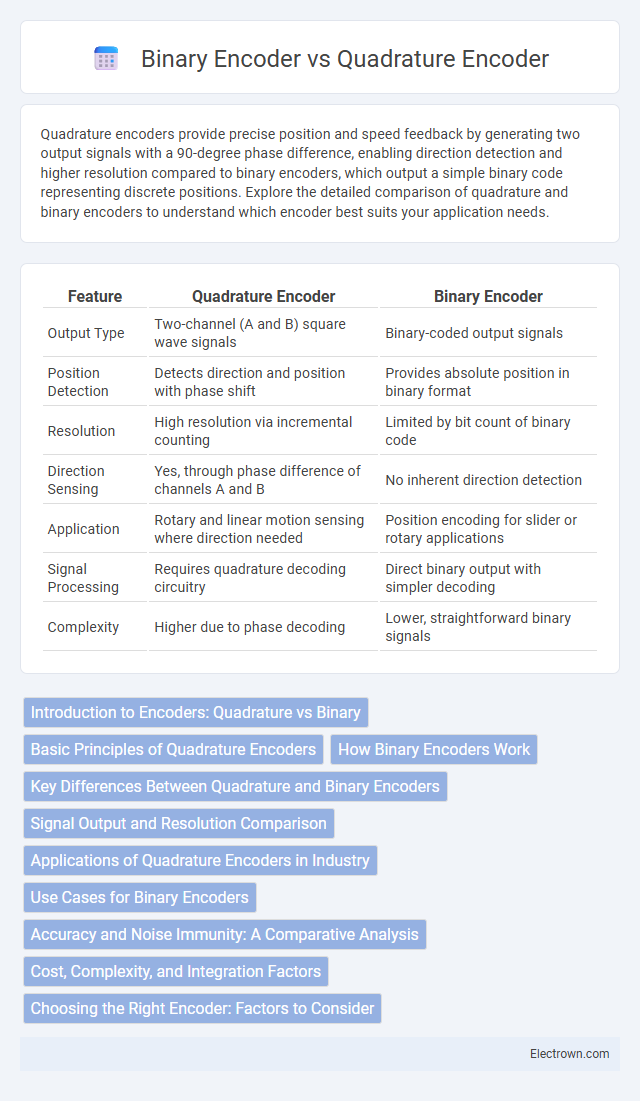Quadrature encoders provide precise position and speed feedback by generating two output signals with a 90-degree phase difference, enabling direction detection and higher resolution compared to binary encoders, which output a simple binary code representing discrete positions. Explore the detailed comparison of quadrature and binary encoders to understand which encoder best suits your application needs.
Table of Comparison
| Feature | Quadrature Encoder | Binary Encoder |
|---|---|---|
| Output Type | Two-channel (A and B) square wave signals | Binary-coded output signals |
| Position Detection | Detects direction and position with phase shift | Provides absolute position in binary format |
| Resolution | High resolution via incremental counting | Limited by bit count of binary code |
| Direction Sensing | Yes, through phase difference of channels A and B | No inherent direction detection |
| Application | Rotary and linear motion sensing where direction needed | Position encoding for slider or rotary applications |
| Signal Processing | Requires quadrature decoding circuitry | Direct binary output with simpler decoding |
| Complexity | Higher due to phase decoding | Lower, straightforward binary signals |
Introduction to Encoders: Quadrature vs Binary
Quadrature encoders provide precise position and direction feedback using two output signals phased 90 degrees apart, ideal for motion control applications requiring high accuracy. Binary encoders output a single digital signal that represents position in binary form, offering simplicity but less directional information. Understanding the differences between your quadrature and binary encoders ensures optimal selection for your automation system's performance.
Basic Principles of Quadrature Encoders
Quadrature encoders use two output signals, typically labeled A and B, which are generated in quadrature phase difference to detect both position and direction of motion with high resolution. These encoders provide incremental pulses that enable precise tracking of angular displacement by counting the rising and falling edges of the signals. Understanding the basic principles of quadrature encoders helps you choose the right sensor for applications requiring accurate rotational position feedback.
How Binary Encoders Work
Binary encoders convert multiple input signals into a binary code by assigning a unique binary number to each active input line, allowing efficient representation of discrete position or state information. They use combinational logic circuits to generate an output corresponding to the highest-priority active input, streamlining the encoding process in digital systems. Understanding how binary encoders work helps you select the right device for applications requiring straightforward binary output, such as position sensing or digital signal processing.
Key Differences Between Quadrature and Binary Encoders
Quadrature encoders provide two output signals shifted by 90 degrees, enabling precise direction and speed detection, while binary encoders deliver a straightforward digital output representing position in binary code. Quadrature encoders excel in applications requiring detailed motion control, such as robotics and CNC machines, whereas binary encoders are suited for simpler position reading tasks. Your choice depends on whether direction information or a direct binary position reference is critical for your application.
Signal Output and Resolution Comparison
Quadrature encoders provide two output signals shifted by 90 degrees, enabling precise direction detection and higher resolution by counting both rising and falling edges of each channel. Binary encoders output a single binary code representing position but lack inherent directional information, typically resulting in lower resolution compared to quadrature encoders. Your choice depends on whether directional accuracy and finer position granularity (quadrature) or simplified position data (binary) better suit your application's requirements.
Applications of Quadrature Encoders in Industry
Quadrature encoders are extensively used in industrial automation for precise position and speed feedback in robotics, CNC machines, and conveyor systems. Their ability to detect direction and provide high-resolution incremental signals makes them ideal for motion control in packaging, printing, and semiconductor manufacturing. Industries rely on quadrature encoders to enhance accuracy, reduce errors, and improve overall equipment efficiency in real-time monitoring and control systems.
Use Cases for Binary Encoders
Binary encoders are commonly used in digital circuits where multiple inputs must be converted into a binary code for simpler processing, such as in priority encoders, interrupt controllers, and keyboard encoding. They efficiently reduce the number of lines required to represent multiple inputs, making them ideal for resource-constrained embedded systems and microcontroller applications. Unlike quadrature encoders, which provide precise positional and directional feedback, binary encoders primarily serve to encode multiple discrete signals into compact binary format for fast digital interpretation.
Accuracy and Noise Immunity: A Comparative Analysis
Quadrature encoders provide higher accuracy than binary encoders by generating two output signals 90 degrees out of phase, enabling precise position and direction measurement with finer resolution. Their differential signal design enhances noise immunity, reducing errors in harsh industrial environments where electrical interference is common. Your choice between these encoders largely depends on the need for precise motion control and robustness against noise in your application.
Cost, Complexity, and Integration Factors
Quadrature encoders typically cost more than binary encoders due to their complex signal output providing higher resolution and direction detection capabilities. The complexity of quadrature encoders arises from their two-channel output system, which requires more sophisticated decoding circuits, whereas binary encoders offer simpler single-channel signals. Integration factors favor binary encoders in applications where cost-efficiency and minimal wiring are crucial, while quadrature encoders excel in precise motion control systems demanding accurate position and speed feedback.
Choosing the Right Encoder: Factors to Consider
Choosing the right encoder depends on your application's resolution, direction detection, and signal processing needs. Quadrature encoders provide precise position and directional information through two phased output signals, ideal for motion control systems requiring incremental feedback. Binary encoders offer absolute position data in a binary format, which suits applications needing immediate position identification without signal interpolation.
Quadrature Encoder vs Binary Encoder Infographic

 electrown.com
electrown.com